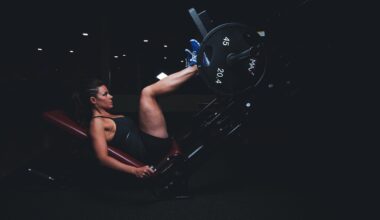Using Treadmills for Rehabilitation and Physical Therapy
Treadmills are essential pieces of equipment frequently utilized in rehabilitation and physical therapy settings. They offer a controlled environment that allows practitioners to monitor patients’ progress unless the patient is using the treadmill for general fitness purposes. Utilizing treadmills can significantly help in regaining strength and improving cardiovascular fitness after injury. The adjustable speed and incline settings on most treadmills let therapists customize sessions tailored to patient needs. Patients often find this equipment convenient and motivating, making their rehabilitation journey more manageable. Rehabilitation experts appreciate treadmills because they provide low-impact exercises, reducing stress on joints while still offering an effective cardiovascular workout. Studies have shown that running or walking on a treadmill can enhance flexibility, strength, and mobility in patients recovering from various injuries. In many cases, patients can also do specific exercises such as high knees and butt kicks while on the treadmill to improve their overall motor skills. Therefore, treadmills serve as a versatile tool in physical therapy, playing a significant role in both recovery and preventative fitness regimens. Regular treadmill usage contributes largely to long-term wellness and a faster return to normal physical activities.
Rehabilitation with treadmills has numerous benefits, particularly for patients recovering from surgeries or chronic injuries. For these individuals, personalized treadmill programs can greatly enhance their overall recovery experience and physical capabilities. When patients follow a structured regimen, they often report feeling more confident and motivated. The safety features found in many treadmill models, like handrails and automatic shut-offs, ensure users can exercise without fear of falling or injury. Additionally, using treadmills can foster a less intimidating environment than outdoor activities, especially important for patients who might feel anxious about regaining movement after an injury. Physical therapists can introduce engaging and targeted exercises on treadmills to make the sessions more enjoyable. Intermittent training methods can also be employed, where intensity levels can be altered to maximize gains. Importantly, as patients progress, they can gradually increase both speed and incline to challenge their bodies further. This gradual increase in intensity prepares them for real-world environments outside of therapy. Through variety and progression, treadmills can help patients regain their baseline fitness levels while minimizing any risk factors present after an injury.
Integrating Treadmills in Therapy Sessions
Incorporating treadmills into therapy sessions provides a structured approach to rehabilitation. Patients can perform warm-up exercises, such as light walking, before transitioning to a treadmill workout. This allows therapists to assess their initial balance and strength. Feedback can easily be gathered throughout the session to identify areas needing improvement or amplification. Varying workout routines and setting specific goals can keep patients engaged and motivated to participate. Integration of technology, such as virtual treadmill programs offering a range of settings or terrains, can elevate traditional therapy methods to new heights. Such innovations can enhance the rehabilitation experience and psychological benefits of treadmill workouts, such as mood improvements and stress reduction. Moreover, patients recovering from surgery often find it easier to observe their progress and success using treadmills. By documenting how far they can walk or run on the machine, they track improvements and celebrate milestones, boosting their confidence and morale. As their fitness develops through periodic assessments of their performance, they can contribute directly to their therapies. This method also encourages ongoing attendance and commitment to achieving long-term wellness goals.
The adaptability of treadmills to various patient needs is another asset to their role in rehabilitation. For instance, patients who have undergone knee surgeries or are dealing with arthritis can utilize treadmills to perform low-impact exercises efficiently. By altering the incline, therapists can focus on different muscle groups while minimizing impact. Improving leg strength and restoring range of motion can be prioritized through specific treadmill routines. Additionally, patients with neurological conditions, such as stroke, benefit from guided walking sessions on treadmills as they’re closely monitored. This close attention allows therapists to adjust the speed and incline based on their devices easily. Patients can also rely on treadmills to develop better gait patterns and balance. The environment allows them to practice essential daily activities in a controlled manner, raising their confidence levels. Multi-faceted approaches using treadmills define the essence of personalized rehabilitation plans. Patients see measurable results in their rehabilitation when treadmills are part of their therapeutic journey, ensuring a smoother transition to daily life after therapy comes to an end.
Understanding Patient Needs in Rehabilitation
Understanding patients’ unique needs is critical in designing effective rehabilitation programs, especially concerning treadmill use. Each individual’s capabilities and progress vary, and therapy should reflect those differences. For patients with cardiovascular concerns, treadmills can be an excellent means to improve heart and lung function, as close monitoring is possible during the sessions. Alternately, patients recovering from orthopedic injuries require careful attention to avoid overexerting themselves, as it may worsen their conditions. The incorporation of treadmills in a holistic treatment plan aids patients by enabling them to work on their stamina while enjoying progressive challenges. Engaging testing features, such as heart rate monitors or calorie counters, provide immediate feedback to both patients and therapists, marking necessary milestones along the way. Regular communication about their experiences and comfort levels is essential to fostering motivation within patients. As therapy continues, therapists can make adjustments according to the patients’ feedback and progression rates. Thus, a patient-centered approach in utilizing treadmills proves essential to enhancing rehabilitation outcomes and overall patient satisfaction during their journeys to recovery.
Monitoring the progress and achievements of patients during rehabilitation on treadmills contributes to their goals. With regular assessments, case studies have reported measurable improvement in both strength and endurance. Establishing tracking methods can help patients visualize their successes and maintain motivation over time. Progress indicators, such as increased speed, distance walked, or incline levels, are powerful motivators for patients focused on recovery. Some rehabilitation centers even utilize digital monitoring systems that automatically record data and provide insights into patients’ progress. This effective cross-analysis means therapists can make informed decisions that align with recovery goals. Maintaining patient accountability is essential and often leads to superior results. Patients feel a sense of ownership and personal achievement as they navigate their rehabilitation. Highlighting progress fosters a positive atmosphere throughout the entire therapeutic experience, reinforcing goals and so improving adherence to recovery protocols. Shared successes between patients and therapists create an empowering bond, increasing therapy effectiveness. Treadmills act as tools for not just physical, but also psychological rehabilitation which collectively enhances the patient experience.
Conclusions and Future Directions
In conclusion, treadmills serve as invaluable instruments in rehabilitation and physical therapy efforts. Their versatility, adaptability, and ability to motivate patients make them critical components for achieving optimal recovery. As technology advances, the integration of smart treadmills that communication advanced tracking and analytics will likely dominate the future of rehabilitation practices. Enhanced treadmill designs will potentially lead to virtual reality environments, which can replicate real-life situations. This approach may significantly bridge the gap between therapy sessions and patients’ daily lives, providing a seamless transition during their recovery journeys. Ongoing training for physical therapists on utilizing these technological advancements will prove essential for shaping effective practices. As the demand for specialized therapy continues to grow, the reliance on innovative solutions, such as treadmill-based rehabilitation, is expected to flourish. As patients experience positive results through personalized treadmill programs, they are likely to endorse these practices to support future rehabilitation efforts with increasing popularity. Ultimately, embracing these trends will deliver sustained benefits, ensuring patients maintain their fitness and health long after their rehabilitation concludes.


